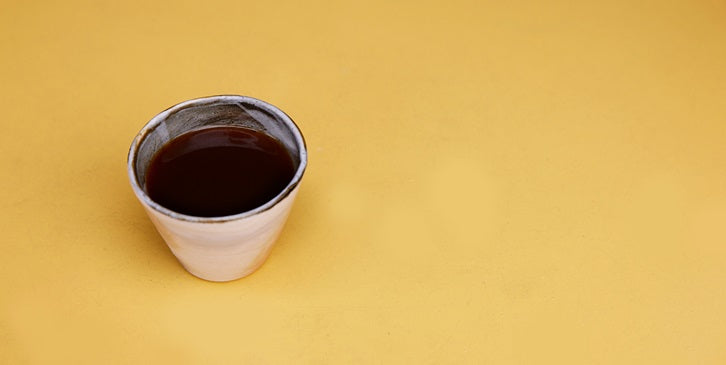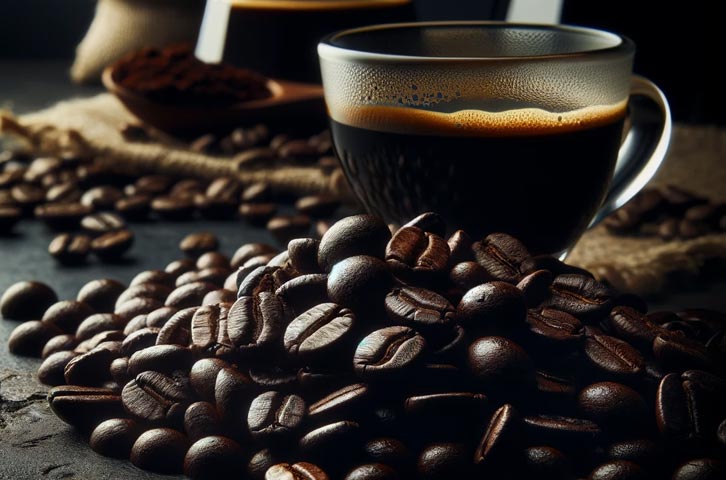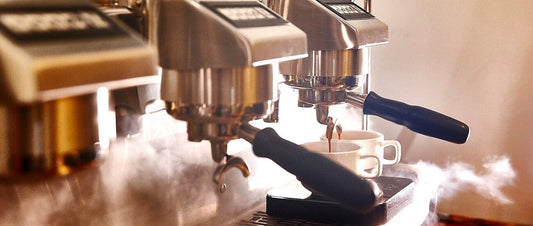
Understanding Coffee Roasts: Guide from Light Roast to Dark Roast
Coffee isn't just a beverage; it's a voyage into the essence of flavor, culture, and complexity. The right roast transforms simple beans into a tapestry of taste, a canvas where every shade of brown tells its unique story. In this ultimate guide, we'll journey through the roasting spectrum, from the lightest roasts that dance on the palate to the darkest roasts that resonate with depth.
Understanding Coffee Roast Levels
Grasp the artistry behind coffee roasts, and you'll appreciate how each roast transforms beans into a full-bodied experience. This alchemy of roasting is what wakes up the bean from its green slumber, coaxing out a symphony of flavors that define your morning cup.
At Bruce Tea & Coffee, we honor this transformation, where simple green beans morph into rich, flavor-packed morsels under the watchful eye of time and temperature.
The roasting journey starts with the green bean, which is subtly transformed by heat, leading to the Maillard reaction—where a chemical ballet creates the comforting, rich flavors that coffee aficionados adore. From the light roast's tangy brightness to the dark roast's smoky depth, each level speaks to a particular palate and preference, defining the coffee experience.
The Spectrum of Coffee Roasts
Imagine coffee roasts as a painter's palette, where each color tells a story of taste and aroma. Starting with light roasts, the beans show off a soft brown color, like cinnamon, hinting at their delicate and complex nature. Move towards the dark side, and the beans take a glossy coat, revealing the flavorful oils that rise to the surface during the roasting process.
Light Roasts
Light roasts are your dawn chorus, a refreshing start to any day. These beans are roasted just until the 'first crack,' marking their readiness with a light pop, signalling the release of their innate moisture and bright acidity. They're packed with subtle, intricate flavors, ranging from citrus zest to floral bouquets. Brewing methods that highlight these nuances, such as AeroPress or pour-over, allow these light roasts to truly shine.

Medium Roasts
Step into the realm of medium roasts, where the Clever Dripper and AeroPress excel in extracting a balanced profile, a union of light roast's liveliness and the beginnings of dark roast's intensity.
These beans transform into a richer, more robust color and flavor, perfectly suited for these innovative brewing methods. Ideal for espresso, filter, or stove-top brewing, they offer a versatile experience.
Enjoy black for a harmonious blend of flavor and texture. Coffees roasted to this degree are often suited with milk which tends to accentuate the caramel tones, sweetness and chocolate characteristics making the most of the Maillard stage in medium roasts.

Medium-Dark Roasts
Enter the world of medium-dark roasts, and the drama unfolds with beans glistening from the oil and taking on a darker hue, edged with the gleam of a roasted chestnut. Here lies a complex landscape of flavor where the sweetness of the beans caramelizes, giving rise to a profile laden with dark chocolate and ripe, fruity undertones. These roasts invite a brewing method that allows their boldness to come forward, like the assertive French press or the precise espresso machine.

Dark Roasts
Dark roasts stand at the edge of the roasting spectrum, their beans swathed in deep, shadowy tones, their surfaces slick with aromatic oils. They resonate with bold flavors, telling tales of smoky undertones and the comforting essence of a well-worn leather chair.
These powerhouse roasts, perfect for the robust Italian espresso and the intense French roast, find their match in the precision of the AeroPress and the richness extracted by the Clever Dripper. These brewing methods skillfully draw out the profound essence of dark roasts. Whether you're crafting an old-school double ristretto or a trendy magic, these tools are superbly suited to handle the intensity and depth of dark roasts

Choosing the Right Roast for You
Selecting a coffee roast is like choosing a soundtrack for your life's moments. It's about aligning your personal taste preferences with the right roast. Do the vivid, sharp notes of a light roast excite your palate, or do you find solace in the smooth, rich embrace of a dark roast? The perfect roast might be basking in the light, filled with tales of its terroir, or lurking in the dark, with flavors as profound as a nocturnal melody.
Contemplate your daily rhythm: a brisk light roast to greet the morning sun or a comforting dark roast to bring your day to a close. The roast you choose is more than a beverage; it's a companion to your culinary creations, a component of your personal story with each sip marking a passage of your day.
The Best Practices for Brewing Each Roast Level
Brewing the perfect cup is both an art and a science. Light roasts favour a larger brew ratio, between 50g-60g/L for filter brewing and around 1:3 ration for espresso brews. As we develop in colour, brew ratios tend to shorten, upwards of 60-80g/L for filter and around the 1:2 ratio for espresso.
Dark roasts are all about boldness, punch and texture. These coffees are suited to the ristretto range of extractions around the 1:1 - 1:1.5 ratio for espresso.
Water quality is the unsung hero in this process. It can elevate a good coffee to greatness or diminish its potential. To ensure your coffee roasts reveal their true character, use water that's as clean and pure as the beans themselves.
A simple filtration medium purchased at your local store will suffice but if you live in parts of the world with particularly hard water i.e. rich in minerals, you might need a more specific medium of filtration, feel free to reach out and we'd be happy to help guide you along the way.
Storing Your Coffee Beans to Maintain Freshness
Imagine your coffee bean storage as a sanctuary, protecting the essence of your brew. Keep beans away from light and air to prevent them from growing stale. An opaque, airtight container is your best bet, ideally kept in a cool, dark corner of your kitchen. Bulk buyers should think like curators, storing most of their beans in a secure, secluded spot, while keeping a smaller, ready-to-use stash at hand.
The freezer should be avoided when storing in bulk, as tempting as it might seem. This can be avoided by vacuum sealing individual portionsIt's not a haven for beans, as the thawing can introduce unwanted moisture, dulling the flavors you treasure. Trust in a cool, dry place to keep your coffee vibrant and as fresh as the day it was roasted.
Pairing Coffee Roasts with Foods
Pairing coffee with food is a connoisseur delight. Light roasts dance alongside the freshness of fruits or the mild sweetness of morning pastries. Medium roasts, the great harmonizers, complement everything from a robust breakfast to a decadent chocolate cake. And dark roasts? They're the bold counterpoint to the richness of grilled meats and the perfect contrast to sweet, sticky desserts.
By exploring these pairings, you create a coffee experience that's not just about a drink, but a complete sensory delight, enhancing every meal with the perfect roast.
Embracing the World of Coffee Roasts
The world of coffee roasts is as vast and varied as the individuals who enjoy them. There's no one-size-fits-all answer, only the roast that fits you. Whether you're brewing a light roast to invigorate your morning routine or sipping a dark roast to unwind, coffee is a personal journey—one that's meant to be savored, explored, and cherished.
Light to Dark FAQs
Which coffee bean is stronger light or dark?
The strength of a coffee bean is often associated with its caffeine content. Typically, light roast beans retain more caffeine than dark roast beans due to less heat exposure during roasting. However, dark roast beans may have a stronger flavor due to the roasting process, which can give a perception of strength.
What is the difference between light and dark roast coffee?
The primary difference between light and dark roast coffee lies in the roasting process. Light roast coffee is roasted for a shorter time, preserving more of the bean's original flavor and caffeine content. Dark roast coffee is roasted longer, leading to a more pronounced flavor, often with smoky or caramelized notes, and slightly less caffeine.
Do darker beans need a finer grind?
Grind size for coffee beans depends more on the brewing method than the roast level. However, darker beans, being more brittle due to extended roasting, may require a slightly coarser grind compared to light roast beans to avoid over-extraction, especially in methods like espresso.
How do you make coffee beans darker?
Coffee beans become darker through prolonged roasting. The roasting process involves heating the beans at high temperatures. As the temperature rises, beans darken and develop the characteristic flavors and aromas of dark roast coffee. The exact time and temperature depend on the desired darkness and roast profile.
Explore our coffee beans selection.




